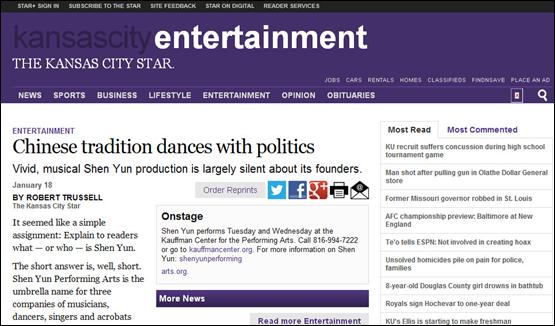It seemed like a simple assignment: Explain to readers what — or who — is Shen Yun.
The short answer is, well, short. Shen Yun Performing Arts is the umbrella name for three companies of musicians, dancers, singers and acrobats reflecting “5,000 years of Chinese culture.” One company is based in New York, another in Europe and a third tours the U.S.
Last year the show played the Music Hall. This year it’s at the Kauffman Center for the Performing Arts.
Getting more concrete information proved to be a challenge. The Shen Yun website does not list staff members or telephone contact information. No artistic director is listed. No executive director. No media relations person. The FAQ page addresses questions about the nature of the show — when it’s OK to applaud, what to wear, whether it’s good for kids — but almost nothing about the organization’s history or founders.
The Kauffman Center provided the name of a local coordinator, who initially said that contacting anyone with Shen Yun was impossible, because “they’re on tour.” Later she said it might be possible to provide performance photos, but only if the organization’s representatives in New York could first read a draft of our article. We passed. The Star’s general policy is to not allow anyone outside the newspaper to read articles before they’re published.
Shen Yun Performing Arts appears to have a relationship to the New Tang Dynasty TV network, but phone calls and emails to a network media relations person went unanswered.
Between the website and scattered news reports, a picture emerges that might explain why Shen Yun founders would keep a low profile. Shen Yun was organized in 2006 by followers of Falun Gong, a spiritual movement that began in 1992 and which the Chinese government has banned.
The Shen Yun website isn’t shy about criticizing the Chinese ruling party. But it implies that the show itself is celebratory, not propagandistic.
“Falun Gong … is guided by the principles of ‘Truthfulness, Compassion, and Tolerance,’ ” reads an essay under the “misconceptions” section of the site. “It has helped over a hundred million Chinese people understand and return to the essence of traditional Chinese culture — Confucian, Buddhist, and Taoist schools of thought. And yet the Chinese Communist Party, whose regime and ideology are in stark contrast with the traditional culture of China, has targeted Falun Gong for persecution.”
A 2011 New York Times story described an ongoing rivalry in a neighborhood of Flushing, Queens, between pro- and anti-Falun Gong activists who passed out literature and have occasionally had physical confrontations.
Falun Gong followers accused their ideological rivals of being agents of the Chinese government, which the Falun Gong critics denied while describing Falun Gong as a “cult.”
In the comment section of the article a reader urged the Times to “follow the money” and find out how “the Falun Gong and their affiliates Epoch Times, New Tang Dynasty Television and Shen Yun Performing Arts … (are) financing their global operations? There are rumors within the Chinese community that it is largely funded with propaganda money from the Taiwanese government. It would be interesting to see if this is, in fact, true.”
A reviewer in Texas in May 2012 described the show as a “variety-song-and-dance show with some banter and humor, and a dose of Falun Gong proselytizing.”
Jasmina Wellinghoff, writing for mysanantonio.com, said that “a lot of it is fun, but the politico-religious aspect is a bit heavy-handed.” She described a sequence in which a man who “tries to stand up for his beliefs is attacked and beaten by police sporting huge red hammer-and-sickle logos on their backs. The fellow eventually gets rescued by mountain fairies and the policemen meet with ‘divine retribution.’ ”
Wellinghoff praised the show generally, citing sequences that “are visually appealing and performed with great verve and precision. Though all the choreography and music are new, the segments feature either Chinese classical dance or folkloric dances from several regions of China.”
(Kansascity.com,January 18,2013)

Original text from::http://www.kansascity.com/2013/01/18/4016041/chinese-tradition-dances-with.html





